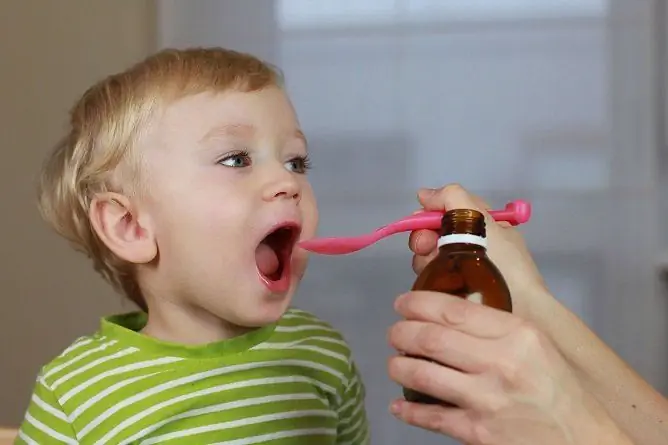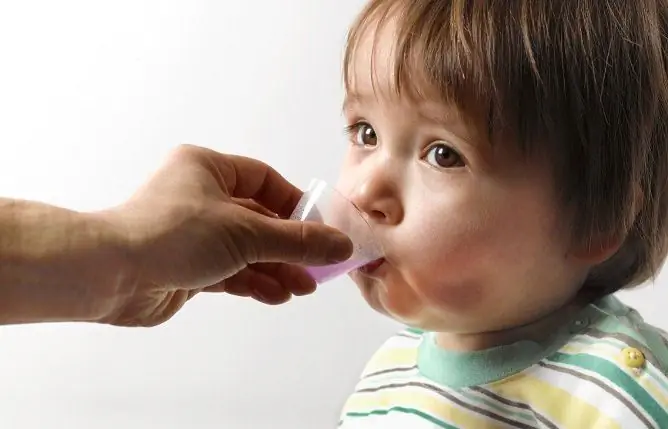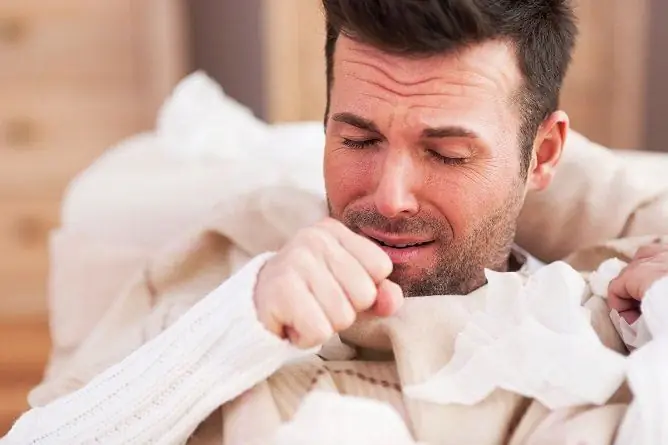- Author Rachel Wainwright [email protected].
- Public 2024-01-15 19:51.
- Last modified 2025-11-02 20:14.
The child's cough does not go away: what to do, how to treat, reasons
The content of the article:
-
Why the child does not cough and what to do
- Why the child's cough does not go away
- Residual cough
- Improper treatment
- Chronic diseases
- Allergy
- Rare causes
- What symptoms to look for
- Survey
-
Treatment
- Etiotropic treatment
- Inhalation
- General recommendations
- Folk remedies
- Video
Why the child does not cough and what to do
If the child's cough persists, this is a reason to see a doctor. There can be several reasons for this condition, ranging from residual effects after ARVI and ending with tuberculosis.
Why the child's cough does not go away
A lingering cough persists for 3 or more weeks. Often it arises as a consequence of the transferred infection and does not pose a danger to the body. But sometimes dangerous diseases lie behind a prolonged cough: tuberculosis, ascariasis, pneumonia, whooping cough.

Most often, a lingering cough is residual, but sometimes it can be a sign of a serious illness
Residual cough
Residual cough occurs due to airway hyperresponsiveness. With inflammation of the respiratory tract, the mucous membrane is damaged, it takes about a month to fully recover. During this time, the child can still cough, although other signs of the disease have disappeared.
The residual process is characterized by:
- there are no other symptoms of the disease;
- there is a positive trend;
- does not affect the general condition of the child;
- sputum production is absent or insignificant.
Improper treatment
The wrong treatment can also lead to the fact that the child coughs for a long time.
There are several points to consider when treating:
- the nature of the cough (wet, dry);
- nature (viral, bacterial);
- the safety of the drug combination.
If you suppress a dry cough, phlegm will accumulate. Sputum stagnation can lead to the attachment of bacterial flora. This happens if, when sputum is released, the child is treated with antitussive drugs. An incorrect combination of drugs can also lead to stagnation of sputum - the simultaneous use of expectorants and antitussives.
Chronic diseases
Chronic diseases are much more difficult to cure than acute ones. Even after prolonged therapy, the symptoms of the disease may persist. In children, a prolonged cough can be caused by the following chronic diseases:
- adenoids and adenoiditis;
- rhinitis;
- tonsillitis;
- pharyngitis;
- bronchitis.
Especially often the cause is chronic pathology of the upper respiratory tract - the nasal cavity, palatine and nasopharyngeal tonsils. The mucus that is produced in the upper respiratory tract flows down the throat and irritates the cough receptors. The cough appears over and over again and is very difficult to get rid of.
Allergy
A prolonged dry cough can be a symptom of an allergy. The child often develops allergies to house dust, pollen, animal hair, and some medicines.
Rare causes
Much less often, a protracted cough is a symptom of pulmonary tuberculosis or intrathoracic lymph nodes, ascariasis, gastroesophageal reflux disease (GERD), whooping cough, and a foreign body in the bronchi.
With these diseases, the cough does not respond to conventional treatment and persists for a long time. Other disease-specific symptoms are also present. For instance:
- heartburn and sour belching - with GERD;
- low-grade fever and increased sweating - with tuberculosis;
- paroxysmal cough, vomiting after an attack - with whooping cough;
- rashes, itching - with ascariasis.
What symptoms to look for
If the child does not stop coughing, you need to pay attention to whether there are other symptoms of the disease:
- Increased body temperature.
- Excretion of sputum, especially mucopurulent or bloody.
- Violation of general well-being: weakness, fatigue, lethargy.
- Difficulty breathing: shortness of breath, attacks of suffocation, pale or blue skin.
- Other signs: increased sweating, heartburn, nasal congestion.
These symptoms are an indication for examining the child. If no additional symptoms are found, the child is feeling well, it is most likely a residual reaction of the body.
Survey
If the child's cough persists for a long time, you need to see a doctor. The doctor will conduct a physical examination: general examination, examination of the oral cavity, auscultation of the lungs, palpation of the lymphatic vessels. If necessary, an additional examination is prescribed:
| Study title | Indications for | Description of results |
| General blood analysis | In all cases | If the cause is an infection - an increase in the level of leukocytes is determined, with allergies and ascariasis - an increase in the level of eosinophils |
| Mantoux test | In all cases | Positive for tuberculosis |
| Chest X-ray | If you suspect pneumonia, tuberculosis | With tuberculosis and pneumonia, focal darkening is determined |
| Allergy tests | If you suspect an allergy | A positive reaction to a specific allergen is determined |
| Bronchoscopy | If you suspect a foreign body in the bronchi | The mucous membrane of the bronchi is assessed, a foreign body is visualized. During bronchoscopy, a foreign body is removed |
Not in all cases, the child is shown an additional examination; the doctor should send for tests.
Treatment
Treatment for a lingering cough depends largely on its cause. In addition to etiotropic treatment (aimed at getting rid of the cause), inhalation, air humidification, and folk remedies are used. For viscous, difficult to separate sputum, drugs from the mucolytic group can be used.
Etiotropic treatment
Cough is not a separate disease, therefore, treating only a symptom in most cases is ineffective. If the cause is identified, treatment should be directed to getting rid of the underlying disease.
| Disease | Specific treatment |
| Allergy |
The main direction is to exclude contact with the allergen. If this is not possible, then drug treatment is used: antihistamines (Suprastin), inhaled glucocorticoids (Budesonide). Desensitization is applied during remission |
| Chronic tonsillitis, adenoiditis |
An integrated approach is used: Sanitation of the focus of infection: rinsing the nose, gargling. Decongestants in a short course: drops Nazivin. With a bacterial infection - antibacterial drugs (Amoxiclav, Azithromycin). With chronic lesions of the tonsils, surgical intervention is often required - adenotomy, tonsillotomy |
| Tuberculosis | Treatment is prescribed by a phthisiatrician. Before starting treatment, you need to determine the sensitivity to anti-tuberculosis drugs. 1st line drugs include Isoniazid, Rifampicin, Ethambutol, Pyrazinamide |
| GERD |
Drugs that reduce acidity are used: proton pump inhibitors (Omeprazole, Pantoprazole) if the child is over 12 years old; histamine blockers (Ranitidine); antacids (Maalox, Almagel) |
| Ascariasis | Anthelmintic drugs: Dekaris, Vermox, Pirantel |
In case of residual effects, etiotropic treatment is not used, it is enough to follow general recommendations and do inhalation.
Inhalation
An effective and simple way of treatment is inhalation. At home, steam and warm inhalations are carried out, you can also use a nebulizer. The essence of the method is that medicinal substances are delivered to the site of inflammation.

For diseases of the lower respiratory tract, inhalation with a nebulizer is indicated.
Steam inhalations are easy to use, but have contraindications: fever, nosebleeds, and the child's age up to 7 years. In addition, when carrying out steam inhalation, there is a risk of burns to the skin and mucous membranes, so you need to be careful. It is recommended to adhere to the following safety rules:
- do not inhale over boiling water (the water temperature should not exceed 50 ° C);
- the frequency of the procedure is no more than 3 times a day;
- the duration of the procedure is 3-5 minutes.
For steam inhalation, decoctions of medicinal herbs, water with soda, and slightly alkaline solutions are used.
Warm inhalations are safer for the baby. There are no contraindications to their implementation, there is no risk of burning the mucous membranes and skin. For the procedure, use warm water (approximately 40 ° C) and essential oils, if the child does not have a tendency to allergies (not used in young children).
With the help of a nebulizer, medicinal substances are delivered directly to the bronchi and bronchioles. For inhalation with a nebulizer, use saline, bronchodilators or antibiotics.
General recommendations
Home treatment will not be effective without following general recommendations:
- Air humidification.
- Plentiful warm drink.
- A diet with the exclusion of irritating foods: spicy, spicy, salty.
- Airing the room in which the child is.
- Do breathing exercises.
- Avoiding hypothermia, inhalation of cold air.
Compliance with general recommendations will help the baby recover faster and get rid of the symptom.
Folk remedies
For treatment, folk remedies can be used that have anti-inflammatory, mucolytic and moisturizing effects. The most commonly used medicinal plants:
- marshmallow root;
- chamomile and calendula flowers;
- mint leaves;
- dog-rose fruit;
- needles of pine and fir.
Decoctions and infusions are prepared from medicinal plants. Use 1 tbsp. l. dry herbs in 1 glass of water. Most often, decoctions and infusions are used for inhalation, but oral administration is also possible.
In addition to medicinal plants, essential oils are also used: eucalyptus, sea buckthorn, pine, tea tree.
It is not recommended to limit yourself to folk recipes. They are used only as an adjunct to the main treatment.
Video
We offer for viewing a video on the topic of the article.

Anna Kozlova Medical journalist About the author
Education: Rostov State Medical University, specialty "General Medicine".
Found a mistake in the text? Select it and press Ctrl + Enter.






